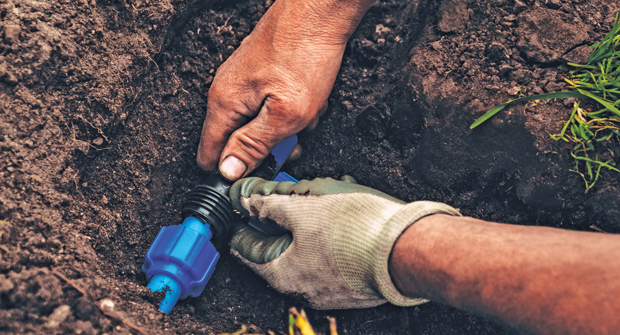Through the Billion Gallon Project, groups are working together to save water in Idaho with smart irrigation systems.
John Balint is by no means a “tree hugger.” He wouldn’t describe himself as a hippie either. But the owner of Mountain High Landscapes in Ketchum, Idaho, is concerned about inefficient water use and the toll it is taking on Wood River Valley’s Big Wood River.
“The river runs straight through the valley and I’m always seeing the effects of not enough snow in the winter and not enough rain in the spring,” Balint says. “We’re irrigating faster than aquifers can recharge and are using more water than is being put into the system. What can we do?”
Balint’s solution to this problem is the Billion Gallon Project, a partnership four years in the making between local landscaping companies and the Sawtooth Botanical Garden. It aims to save 1 billion gallons of domestic irrigation water in the next four years through an increased use of smart irrigation systems and techniques. Balint, chair of Sawtooth Botanical Garden’s board of directors, has corralled other board members, local landscape contractors, irrigation suppliers, environmental nonprofits, municipalities and homeowners to recognize the importance of this initiative and to support the idea of everyone stepping up their games to save water.
“We all agreed it’s not about making money, it’s about doing the right thing and saving water,” Balint says. Less than a year ago he left a previous employer to found Mountain High, a $600,000 company that offers 50 percent maintenance, 35 percent design/build, and 15 percent irrigation services to residential clientele. “We are reeducating the entire valley on how to do irrigation system upgrades and installations properly.”
Balint estimates that 3 billion to 4 billion gallons of water are used by domestic irrigation systems in Wood River Valley annually. The Billion Gallon Project aims to upgrade 2,000 to 2,500 of the estimated 8,000 to 10,000 irrigation systems in the region by the end of 2017. These new smart systems are expected to reduce irrigation water use by 200 million to 300 million gallons each year, producing 1 billion gallons in savings within the four-year timeline. While smart irrigation technology is not new, Balint says it’s finally become affordable for the average homeowner, making it possible for almost anyone to irrigate his or her lawn as efficiently as possible.
Balint has spearheaded the Billion Gallon Project with representatives from two local irrigation companies and the manager of the Wood River Land Trust. All are members of the Botanical Garden’s board of directors. The group first contacted about 10 of the region’s largest landscape companies (any company with 100 or more clients), hoping to get them on board. This fall and winter, the team will approach mid-level companies and “move down the line” until every landscape company in the valley has the opportunity to participate, Balint says. Once on board, each company recommends an employee to complete an intensive in-class and online certification program, provided for free by local irrigation supply companies, on installing smart irrigation systems and components and retrofitting existing systems to be more efficient.
“We felt that if we had all the main contractors on board there would be less pushback from clients,” Balint says. “Also, these companies have the infrastructure to do the training and will have a bigger impact more quickly.”
For Balint, training is the key aspect to ensuring success. Even a smart system will water inadequately if not installed correctly. Training for the first batch of Billion Gallon Project contractors began in February. They’re expected to complete the education by the end of summer. Certified contractors also take part in a full system retrofit, which serves as the hands-on portion of the training. Despite the extensive training and certification, Balint urges any contractors involved in the program to use its tight network of individuals and organizations there to help each step of the way.
“We’re approaching it in a common-sense way: If you’re not super familiar with this, do your clients that are easiest to retrofit first so there are fewer mistakes,” Balint says. “We can’t just fly through this stuff and hope it’s right, so if you have a question, ask. We want anything said about this project to be positive.”
To ensure that any homeowner in the Wood River Valley can take advantage of the Billion Gallon Project, there’s a special fee structure in place for those who can’t afford the $300 to $1,000 in parts and labor costs. Contractors have agreed to offer payment plans, allowing customers to make payments based on the savings reflected on their water bills. Balint asks contractors to be flexible with their clients, help them budget, or even offer to do extensive upgrades in affordable phases.
“We are asking contractors to be as inclusive as they can,” Balint says. “It may take a few years to pay off, but we’re asking contractors to stretch a little bit for customers who can’t afford this.”
While similar ideas have been tried in other places, Balint doesn’t know of an initiative as thorough or far-reaching as the Billion Gallon Project. Most of the other programs are product related and involve the promotion of one component of a smart irrigation system to save water. Feedback Balint has received so far is that no other program has been embraced by such a wide variety of groups, has focused so intently on proper training or has offered flexible payment options for homeowners. For Balint, this feedback alone is proof the program is successful, but he’s also looking forward to the day they save that first billion gallons.
“To some, success is numbers driven. To others, it’s culturally driven—to be a culture that wants to save water,” he says. “We no longer want to settle for installing sprinkler systems that just get stuff wet.”
Photos: Mountain High Landscapes

